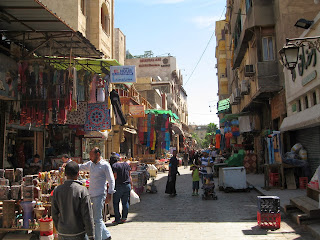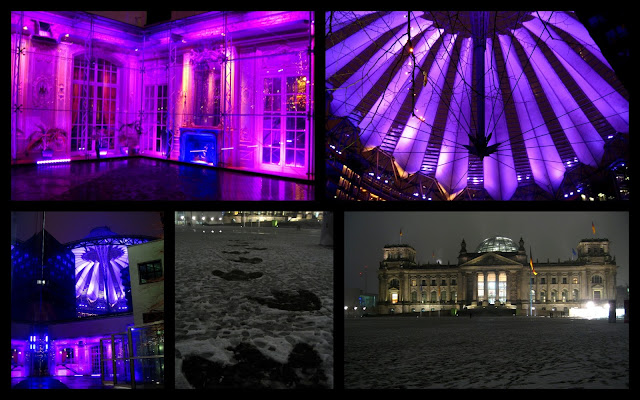Prague is one of those places everyone tells you you should
go. Unfortunately, Prague is not a main
air destination and neither is Sofia.
That makes plane tickets between the two very expensive. However, after a little search, I bought a
cheap plane ticket to Vienna and a bus ticket to Prague.
 After dropping off my stuff, I headed out to see the
sites. I took tram 22, which would
become my most frequented tram, and just chose a place that looked interesting
to hop off. I walked down the streets
past beautiful buildings and through nice courtyards until I reached the Charles
University Botanical Gardens. I just
wandered through a gate in the wall and looked around a bit. It was only May, so they weren’t in full
bloom yet, but there were still a lot of pretty spring flowers.
After dropping off my stuff, I headed out to see the
sites. I took tram 22, which would
become my most frequented tram, and just chose a place that looked interesting
to hop off. I walked down the streets
past beautiful buildings and through nice courtyards until I reached the Charles
University Botanical Gardens. I just
wandered through a gate in the wall and looked around a bit. It was only May, so they weren’t in full
bloom yet, but there were still a lot of pretty spring flowers.
 The Lennon Wall has been filled with John Lennon inspired graffiti.
It
originated after Lennon's murder and evolved into a way to complain and rebel against the Communist regime in the
1980’s. The government was not amused
and called the artists “agents of Western capitalism,” which of course, was the
lowest of the low behind the Iron Curtain.
Most of the original graffiti is covered with new graffiti, some of it
in line with the John Lennon/Beatles theme and some of it is of Spider Man, but
it was a quick stop, it was free, and the history is interesting.
The Lennon Wall has been filled with John Lennon inspired graffiti.
It
originated after Lennon's murder and evolved into a way to complain and rebel against the Communist regime in the
1980’s. The government was not amused
and called the artists “agents of Western capitalism,” which of course, was the
lowest of the low behind the Iron Curtain.
Most of the original graffiti is covered with new graffiti, some of it
in line with the John Lennon/Beatles theme and some of it is of Spider Man, but
it was a quick stop, it was free, and the history is interesting.
After tearing up a little bit at the “Four Paws” display in
the Sofia Airport (sad animal stories always get me), I made it to Vienna and
made my way to the hostel that was the nearest to the bus station as I could
manage while still staying within my requirements for safety and
cleanliness.
After breakfast the next morning, I set off in the rain to
find the place along the road where the “big yellow bus” would pick me up. The website made it sound really obvious and
I found the correct street, but the sign for the bus stop was tiny and on the
opposite side of the street, so I completely missed it, walked about 2 blocks
too far, looked back, saw that the big yellow bus had arrived, and hauled
myself back to it.
Once aboard, I was off to the Czech Republic. I like taking buses and trains
sometimes. Although they are not as
fast, you pass through towns and countryside that you normally wouldn’t get to
see. I got to Prague and proceeded to
follow the instructions to my hostel.
Unfortunately, the hostel did not update said instructions to account
for a lot of road construction in the area.
The tram that normally goes right by no longer did. So, after trying the tram a couple of times
(I thought maybe I just got the direction wrong), I just found the right cross
street and walked. Luckily, it wasn’t
that far anyway.
 After dropping off my stuff, I headed out to see the
sites. I took tram 22, which would
become my most frequented tram, and just chose a place that looked interesting
to hop off. I walked down the streets
past beautiful buildings and through nice courtyards until I reached the Charles
University Botanical Gardens. I just
wandered through a gate in the wall and looked around a bit. It was only May, so they weren’t in full
bloom yet, but there were still a lot of pretty spring flowers.
After dropping off my stuff, I headed out to see the
sites. I took tram 22, which would
become my most frequented tram, and just chose a place that looked interesting
to hop off. I walked down the streets
past beautiful buildings and through nice courtyards until I reached the Charles
University Botanical Gardens. I just
wandered through a gate in the wall and looked around a bit. It was only May, so they weren’t in full
bloom yet, but there were still a lot of pretty spring flowers.
I continued winding my way through the New Town down to the
Dancing House. This building is shaped like a man and a woman
dancing, so some call it “Fred and Ginger.”
Apparently its official name is the Raisin Building. Apparently some official names are dumb.
From there I walked down the river towards the castle
admiring buildings, swans, and the national theatre before crossing the Vltava
River. I walked through a part with giant
faceless baby sculptures and some sort of maritime structure with penguins on
top. I was on my way to the Lennon Wall
and after turning through many old streets (a couple more than once), I
arrived.
 The Lennon Wall has been filled with John Lennon inspired graffiti.
It
originated after Lennon's murder and evolved into a way to complain and rebel against the Communist regime in the
1980’s. The government was not amused
and called the artists “agents of Western capitalism,” which of course, was the
lowest of the low behind the Iron Curtain.
Most of the original graffiti is covered with new graffiti, some of it
in line with the John Lennon/Beatles theme and some of it is of Spider Man, but
it was a quick stop, it was free, and the history is interesting.
The Lennon Wall has been filled with John Lennon inspired graffiti.
It
originated after Lennon's murder and evolved into a way to complain and rebel against the Communist regime in the
1980’s. The government was not amused
and called the artists “agents of Western capitalism,” which of course, was the
lowest of the low behind the Iron Curtain.
Most of the original graffiti is covered with new graffiti, some of it
in line with the John Lennon/Beatles theme and some of it is of Spider Man, but
it was a quick stop, it was free, and the history is interesting.
I meandered back across the river and took some pictures of
the Dancing House and the castle lit up at night. I found out that the Old Town Bridge Tower was
still open. The tower was completed in
1380 as part of Prague’s fortification system.
138 stairs later, I was on the outside of the roof taking in a great
view of Charles Bridge and several of Prague’s other towers and churches. On my way back down, I passed a creepy
sculpture at the top of the stairs that I hadn’t even noticed on the way up and
stopped to take in a room with an impressive beamed ceiling lined with old
coats of arms. After exiting the tower,
I was done for the day and hopped back on the tram to my hostel.

































